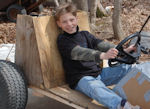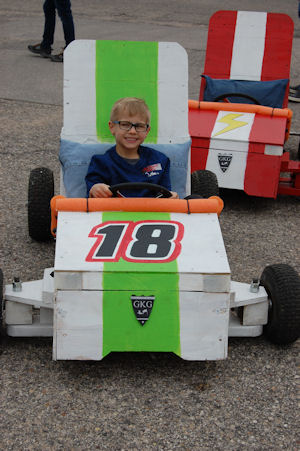You may have observed or you may have heard through the grapevine that the wood go kart uses a wood pulley. The wood pulley however has some little tricks to it and if you don’t pay attention to these little tricks you’ll end up with a wobbly wood pulley.
In this article were going to discuss how to do the following things:
– Set up a pilot discs
– center the main wood pulley blank
– and cut the wood pulley groove
First of all the wood pulley, that was designed for the wood go kart, was designed for a one wheel drive go kart. The wood pulley that was developed would not work real well by itself, it is not designed for a live axle system. The reason being is that the live axle pulley requires a hub. This particular wood pulley uses the wheel as the hub.
The wood pulley basically is about 85% the diameter of the tire that you’re going to use. To get the wood pulley to drive the tire or rim a connection between the wood pulley and a tire/rim is needed.
The intermediate section is called the pilot. Basically a pilot keeps the wood pulley centered on the wheel and then connects the wood pulley to the wheel. Because of the nature of the stresses involved with go kart frameworks and so forth the best solution is to have the axle support as close to the rim as possible. So what is required in the end is that the pilot and the wood pulley are hogged out or hollowed out so that the support framework from the wood go kart can pass through and provide proper support so that the axle does not bend.
The key here is understanding that the pilot and the main drive disk need to be orientated relative to each other before a bunch of work is done on them.
The pilot disk basically is a piece of wood that is the same diameter as the rim bead on the wheel. It gains its support from the metal rim bead or bent over section and keeps the forces that are generated by the pulley and transfers them into the wheel laterally.
Cutting The Pulley Groove
The pulley groove is an important concept in that it’s designed to wedge the belt down in the groove. This wedging action actually causes more forces to be generated as the load from the motor is being exerted. What happens is the wedging action of the groove causes the belted pull tighter or wedged down into the groove with more force.
So it is key to understand that the groove is important to the design of the pulley. Actual fabrication of the “V” groove is another matter however.
The groove can be generated by cutting a 45° angle on one side of the pulley blank, then made into pulley blanks together, will form a wood pulley. Cutting the groove into a rounded disc can be tricky, however.
I shudder to think of methods using saws and so forth. The safest methods to making a V or a 45° edge is to use a router. A secondary method would be to try to generate a V. groove using a belt sander. I think that you would be spending a large amount of time, like three hours trying to generate a V. groove using a belt sander. A simple router table can do the job in a matter of minutes. Obviously you need to be qualified and the proper age and oversite to run the wood working equipment.
Depending on how well you came up with your pulley discs will determine how uniform your two “V” grooves are going be. At this point the two discs are matched up as well as they can be relative to each other and re-examined for the groove alignment.
The discs are then screwed together using drywall screws. It is a good idea to use some wood glue to enhance the bond between the two plates. Keep in mind that forces from the belt are going to be generated out at the rim of the pulley so good fastening is required on the outside section of the pulley.
Note: using drywall screws is a good idea, however the tips of the drywall screws typically come out the other side of the wood blanks. Be sure to sand off the tips using a belt sander so that nobody gets nicked or scraped with these sharp edges.
When the blank was developed a pilot hole should have been developed in the center as well. I typically use the size of the shaft which is on the go kart, which typically is three quarters of an inch in diameter.
It is critical to get the centerpoint identified right away. When we generated our discs we used a compass that we developed, as is shown on the wood go kart video (coming soon), and the centerpoint is identified easily from this compass. The hole that was drilled will be used as a pilot to orientate the discs to the wheel.
To line up to the pilot discs, wood pulley blanks and the wheel, insert an axle shaft into the tire,the pilot and the wood blank. If you do not have the piece of axle sitting around a simple three-quarter inch diameter wood dowel will do the trick.
Drywall screw all the discs together. Glue will enhance the bond and will make the pulley system stronger.
To make the wood pulley mate up with the metal rim, the simplest method is to find holes that exist already in the rim and insert bolts through those holes and into the wood pulley. If these holes do not exist in the rim, then drill your own. This can be a complication in that it may be difficult to line up the holes that you are drilling into the metal rim with the wood pulley.
Actually it’s not that difficult, all you have to do is maintain the position of the wood pulley in the rim and then fire your drill through the metal rim and through the wood pulley. Be sure to drill at least two holes.
You’ll need a long lag bolt to hold the wood pulley to the metal rim. You may want to bury the head of the bolt into the side of the wood pulley. The bolt head sticking out may cause interference as it is going by the framework of the wood go kart when the tire/rim is rotated.
The next step is to hog out material internal to the pulley and the pilot so that the shaft and the wood framework can fit inside the wood pulley and mate up with the rim of the tire. This may seem like an unnecessary and ridiculous step, however if you look at it from a strength and material standpoint you will understand that this step is needed, especially if you’re using a three-quarter inch diameter shaft. The three-quarter inch diameter shaft needs to be supported otherwise it will bend severely and this whole go kart project will go by the wayside.
This Is Where The Second Conundrum Appears
You will find it when you’re developing a go kart by yourself it becomes a chess game. In that you need to be thinking five steps ahead before you start cutting up, drilling, sawing and welding. You need to see far ahead and design your go kart around the problems that will be encountered in the future. This is one such problem.
The problem is that the lag bolts that you put into hold the wood pulley in place need to have enough material to bite into and also provide you enough room for clearance so that the axle support can be held in place.
So before you start drilling holes in the rim, make sure there’s enough room, or enough material for strength to hold the bolts, to hold the wood pulley in place and to provide the torque transfer from the pulley to the wheel without cracking and breaking.
Ideally, the bolts should be way out on the outside of the rim section if it is possible. A rule of thumb for wood pulley’s, is that the larger the tire the better off you are because there is more inside room to play with. So if you’re planning on using a smaller rim, a wood pulley may not actually work in this instance because there may not be enough room for support.
In Conclusion:
A wood pulley can save you about $50 in that it is something that you can develop yourself, and you don’t have to buy it at a store custom. However, the wood pulley is not just a straightforward slap together project. Be sure to check the following things before making the design complete:
– Pilot Hole Size
– Rim Hole Positioning
– Overall Rim Diameter
Be sure to keep the alignment between the pilot, the wood pulley blanks and the rim concentric so that you do not have an offset wobble that occurs and causes vibration or belt problems in your wood gokart wood pulley driveline.
Wood you believe that?!
For pictures and applications dynamics visit the Wood Go Kart Building Bundle….


